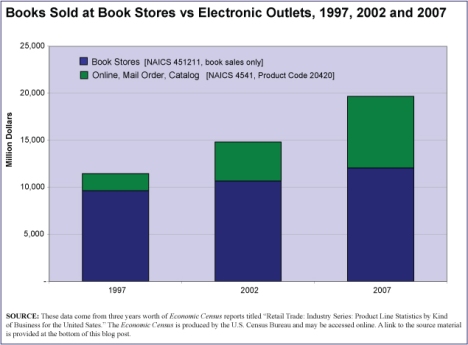We pick up again on the topic we started way back on June 30, namely, how are books sold these days? In our first look at the economic statistics available on U.S. book stores we saw three very interesting things.
1. That while book store sales between 1997 and 2007 rose by 35.4% the sale of actual books rose by far less (25.1%).
2. That sales of things other than books grew fastest, increasing 71.7% between 1997 and 2007.
3. That within the book category, textbooks by far outpaced all other books in terms of dollar sales growth, in fact, text book sales grew by 123.2% while the sale of all non textbook books actually declined by 0.9%.
Now, because these data do not include coverage of eBooks, we decided to try and look into those as well. What we found is that they are still very, very hard to track through any reliable, national level statistics, yet. The U.S. Census Bureau has begun to track eBooks but it will take a few years before their survey data provides us with the sort of detail we need in order to make sense of this crazy time of transition.
In the meantime, we can take a look at books sold electronically and add those to the overall sale of books through book stores.
Books have long been sold by book stores as well as outlets other than book stores, like catalog companies, book clubs and since the mid-1990 electronically through the Internet. The bar chart above shows the dollar value of books sold through book stores (including text books) and books sold electronically and through mail order houses. The U.S. Census Bureau has been tracking retail sales through these different outlets for some time now. What is not clear yet is how much of the eBook market is being captured by these Census Bureau categories. We suspect that it does not yet capture eBook sales reliably.
Nonetheless, what is abundantly clear from these data already—and is hardly surprising to anyone following this subject—is the fact that more and more of the books we buy we are buying electronically, online.
Worth noting is the fact that some of the electronic sales measured in the data graphed here are, in fact, electronic sales made by companies that also operate physical book stores. The gorilla in the market is, however, Amazon which has overtaken Barnes & Noble to become the largest book retailer in the United States. This occurred in each company’s fiscal 2009 when Amazon had net, North American “media” sales of $5.96 billion and Barnes & Noble’s sales totaled $5.12 billon (figures come from each company’s SEC filing for 2009).
Perhaps we should try charting some of these corporate sales figures against some of the Census data in our next post.
Source Note:
1997 Census Data here
2002 Census Data here
2007 Census Data here
Filed under: Amazon.com, Barnes & Noble, Book Sales, Book Stores | Leave a comment »





